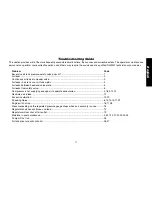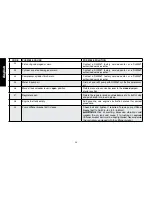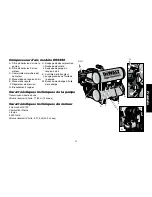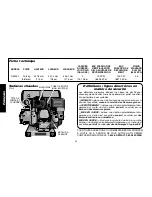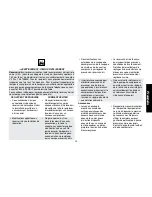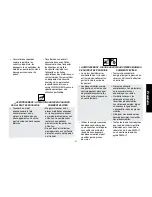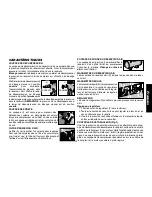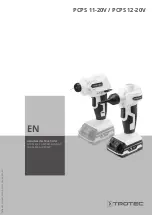
14
E
n
g
li
sh
** The pump oil must be changed after the first 0 hours or operation.
Thereafter, when using
D
e
WALT
synthetic compressor oil, change oil
every 00 hours of operation or once a year, whichever comes first.
+ Perform more frequent in dusty or humid conditions
Checking Safety valve (Fig. 1)
WARNING: Hot surfaces. Risk of burn. Aftercooler, pump head, and
surrounding parts are very hot, do not touch (see the Hot Surfaces
identified in Fig. 2). Allow compressor to cool prior to servicing.
WARNING: Risk of bursting. If the safety valve does not work
properly, over-pressurization may occur, causing air tank rupture or
an explosion.
Before starting compressor, pull the ring on the safety valve to
make sure that the safety valve operates freely. If the valve is stuck
or does not operate smoothly, it must be replaced with the same
type of valve.
Checking Air Filter Element (Fig. 1)
WARNING: Hot surfaces. Risk of burn. Aftercooler, pump head, and
surrounding parts are very hot, do not touch (see the Hot Surfaces
identified in Fig. 2). Allow compressor to cool prior to servicing.
1. Ensure engine ON/OFF switch (C) is in the OFF Position.
. Allow unit to cool.
3. Unscrew air filter (A) from unit.
4. Carefully pry filter top from base.
5. Remove element from filter base.
6. If element needs cleaning, blow out with air. Replace if needed.
Purchase replacement parts from your local dealer or authorized
service center. Always use identical replacement parts.
7. Place element back in filter base.
8. Snap filter top to filter base.
9. Reassemble air filter to unit. Ensure exhaust
A
N
outlet (N) points down.
CAUTION: Risk of unsafe operation. Do not
operate without air inlet filter
Draining Air Tank (Fig. 1)
WARNING: Risk of unsafe operation. Risk from noise. Air tanks
contain high pressure air. Keep face and other body parts away
from outlet of drain. Use safety glasses when draining as debris can
be kicked up into face. Use ear protection as air flow noise is loud
when draining.
note: All compressed air systems generate condensate that
accumulates in any drain point (e.g. tanks, filter, aftercoolers,
dryers). This condensate contains lubricating oil and/or substances
which may be regulated and must be disposed of in accordance with
local, state, and federal laws and regulations.
1. Ensure engine ON/OFF switch (C) is in the OFF Position.
. Move compressor into an inclined position so drain valve (J) is
at the lowest point (this will assist in removing moisture, dirt, etc.
from air tanks)
3. Place a suitable container under the drain valve to catch
discharge.
CAUTION: Risk of property damage. Drain water from air tank may
contain oil and rust, which can cause stains.
4. Grasp knurled knob on drain valve.
5. Slowly rotate knob to gradually bleed air from air tank.
6. When air tank pressure gauge reads 10 PSI (68,9 kPa), rotate
valve to the fully open position.
7. Close drain valve when finished.

















